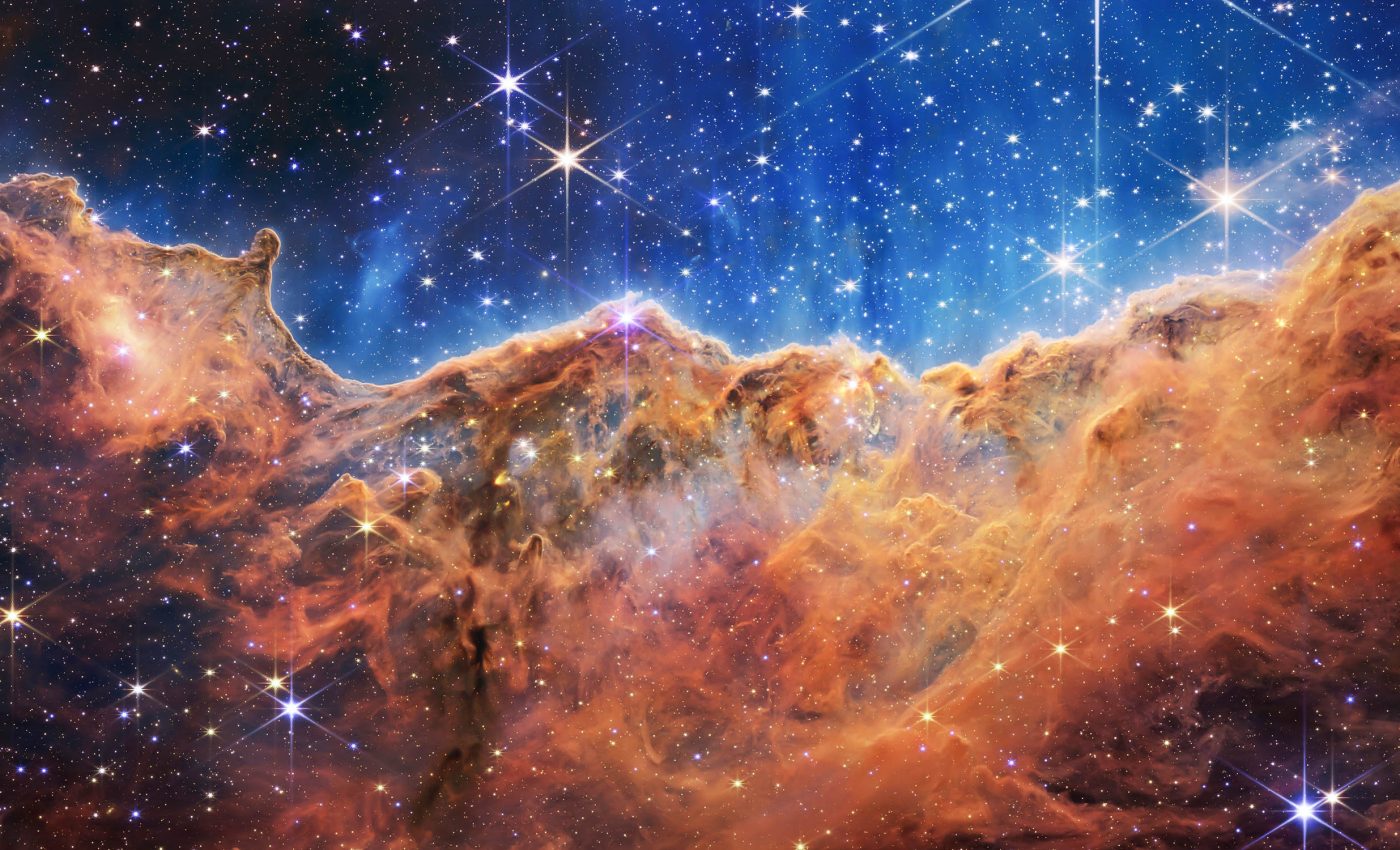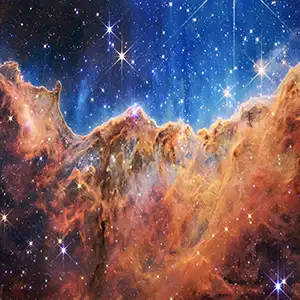
Webb's iconic 'Cosmic Cliffs' image transformed into stunning 3D video tour of a star nursery
A famous James Webb Space Telescope portrait has recently gained a fresh dimension. Scientists have transformed the “Cosmic Cliffs” image, first revealed in July 2022, into a sweeping three‑dimensional fly‑through that lets audiences dive into a glittering nursery of stars.
The new visualization comes from NASA’s Universe of Learning program and premieres today during a centennial celebration of the first public planetarium, held by the International Planetarium Society in Munich.
3D view of star nursery
The source photograph shows a jagged wall of gas and dust that looks like mountains lit by starlight. In reality, this cliff is a section of the nebula Gum 31 inside the sprawling Carina Nebula Complex.
At its top, unseen in the Webb frame, sits the young star cluster NGC 3324. The cluster’s ultraviolet glare and fierce stellar winds have hollowed out a vast cavity in the nebula. The Cosmic Cliffs mark one edge of that bubble.
Webb’s near‑infrared eyes caught the cliff as wisps of blue and gold, speckled with points of baby stars. The new 3D tour adds depth cues so viewers can sense soaring peaks and plunging valleys.
Streams of heated gas flow upward like mist across the ridge. Bright yellow arcs trace jets erupting from infant suns as they burrow through the cloud.
Star science becomes visual art
“Bringing this amazing Webb image to life helps the public to comprehend the three‑dimensional structure inherent in the 2D image, and to develop a better mental model of the universe,” said Space Telescope Science Institute (STScI) visualization scientist Frank Summers, who heads the AstroViz Project that crafted the sequence.
The piece forms part of a longer narrated video created by the STScI with partners at Caltech/IPAC.
Designed for planetariums, museums, and classrooms, the production links the epic scene to the tools and methods astronomers use to study stellar birth.
Century of planetarium storytelling
The Munich event that hosts the debut honors one hundred years since the first public planetarium opened in the same city.
Today almost two hundred U.S. sites run ViewSpace, a free video exhibit from NASA’s Universe of Learning.
The Cosmic Cliffs fly‑through will join that platform along with an online resource page dedicated to the Carina Nebula Complex.
Interactive tools let visitors zoom into telescope images and compare wavelengths, bringing space science into local communities far from observatory domes.
Star birth inside the cosmic cliffs
Gum 31, formed of hydrogen, helium, and cosmic dust, sits about 7,600 light‑years away in the southern constellation Carina. Within it, the stars of NGC 3324 are only a few million years old.
Their radiation blasts the surrounding cloud, carving the void above the cliffs. Where gas is denser, pillars endure.
At their tips, gravity squeezes material until new stars ignite. Webb’s infrared sensitivity reveals these hidden embryos, blanketed in cooler dust that once made them invisible to optical telescopes.
The visualization translates scientific data into a sculpted digital mesh. Color layers from Webb’s detectors wrap the mesh, while particle systems simulate drifting gas.
To keep the rendering faithful, artists consulted astrophysicists about distances, densities, and light scattering. The result is not a literal map but a guided impression that honors the physics behind the picture.
Webb changes cosmic understanding
NASA’s Universe of Learning draws on missions such as Webb, Hubble, Chandra, Spitzer, and others.
The program blends expert interviews, data sonifications, and visual effects to answer core questions: how do stars form, how do galaxies evolve, what lies beyond our solar system.
It belongs to NASA’s Science Activation network, which links scientists with educators to “activate minds” through authentic content.
The James Webb Space Telescope continues to redefine what we know about the cosmos.

Since launch in late 2021, it has probed the atmospheres of exoplanets, spotted some of the earliest galaxies, and detailed the architecture of star‑forming regions.
The Cosmic Cliffs image was part of Webb’s first public showcase and quickly became an icon. Converting that single frame into a flight experience deepens public engagement and underscores Webb’s power to reveal structures hidden by dust.
Future Webb visuals planned
The AstroViz team plans similar 3D treatments for other Webb highlights, each tailored to different learning settings.
As tools evolve, future versions may let viewers steer their own path through nebulae using virtual‑reality headsets.
For now the new sequence will roll out to planetariums worldwide, inviting audiences to soar above a stellar cliff face, watch hot gas billow skyward, and glimpse newborn suns firing jets into the dark.
Webb’s images already inspire awe. With depth added, they can also nurture intuition about scale and process, turning distant astrophysical drama into an immersive story that anyone can feel as well as see.
Click here to watch the full 3D video of the “Cosmic Cliffs” by JWST…
—–
Like what you read? Subscribe to our newsletter for engaging articles, exclusive content, and the latest updates.
Check us out on EarthSnap, a free app brought to you by Eric Ralls and Earth.com.
—–













